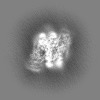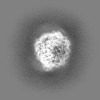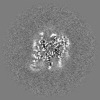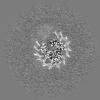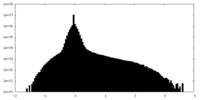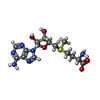[English] 日本語
 Yorodumi
Yorodumi- EMDB-33127: Cryo-EM structure of Dot1L and H2BK34ub-H3K79Nle nucleosome 2:1 c... -
+ Open data
Open data
- Basic information
Basic information
| Entry |  | ||||||||||||||||||
|---|---|---|---|---|---|---|---|---|---|---|---|---|---|---|---|---|---|---|---|
| Title | Cryo-EM structure of Dot1L and H2BK34ub-H3K79Nle nucleosome 2:1 complex | ||||||||||||||||||
 Map data Map data | |||||||||||||||||||
 Sample Sample |
| ||||||||||||||||||
 Keywords Keywords | Complex / Dot1L / H2BK34ub / Nucleosome / NUCLEAR PROTEIN | ||||||||||||||||||
| Function / homology |  Function and homology information Function and homology information[histone H3]-lysine79 N-trimethyltransferase / histone H3K79 methyltransferase activity / histone H3K79 trimethyltransferase activity / regulation of transcription regulatory region DNA binding / hypothalamus gonadotrophin-releasing hormone neuron development / female meiosis I / positive regulation of protein monoubiquitination / regulation of receptor signaling pathway via JAK-STAT / fat pad development / mitochondrion transport along microtubule ...[histone H3]-lysine79 N-trimethyltransferase / histone H3K79 methyltransferase activity / histone H3K79 trimethyltransferase activity / regulation of transcription regulatory region DNA binding / hypothalamus gonadotrophin-releasing hormone neuron development / female meiosis I / positive regulation of protein monoubiquitination / regulation of receptor signaling pathway via JAK-STAT / fat pad development / mitochondrion transport along microtubule / histone H3 methyltransferase activity / histone methyltransferase activity / female gonad development / seminiferous tubule development / male meiosis I / positive regulation of intrinsic apoptotic signaling pathway by p53 class mediator / subtelomeric heterochromatin formation / energy homeostasis / Replacement of protamines by nucleosomes in the male pronucleus / regulation of neuron apoptotic process / neuron projection morphogenesis / regulation of proteasomal protein catabolic process / Packaging Of Telomere Ends / Maturation of protein E / Maturation of protein E / ER Quality Control Compartment (ERQC) / Myoclonic epilepsy of Lafora / Recognition and association of DNA glycosylase with site containing an affected purine / Cleavage of the damaged purine / FLT3 signaling by CBL mutants / IRAK2 mediated activation of TAK1 complex / Prevention of phagosomal-lysosomal fusion / Alpha-protein kinase 1 signaling pathway / Glycogen synthesis / IRAK1 recruits IKK complex / IRAK1 recruits IKK complex upon TLR7/8 or 9 stimulation / Endosomal Sorting Complex Required For Transport (ESCRT) / Deposition of new CENPA-containing nucleosomes at the centromere / Membrane binding and targetting of GAG proteins / Negative regulation of FLT3 / Regulation of TBK1, IKKε (IKBKE)-mediated activation of IRF3, IRF7 / PTK6 Regulates RTKs and Their Effectors AKT1 and DOK1 / Regulation of TBK1, IKKε-mediated activation of IRF3, IRF7 upon TLR3 ligation / Constitutive Signaling by NOTCH1 HD Domain Mutants / IRAK2 mediated activation of TAK1 complex upon TLR7/8 or 9 stimulation / NOTCH2 Activation and Transmission of Signal to the Nucleus / TICAM1,TRAF6-dependent induction of TAK1 complex / TICAM1-dependent activation of IRF3/IRF7 / APC/C:Cdc20 mediated degradation of Cyclin B / telomere organization / Recognition and association of DNA glycosylase with site containing an affected pyrimidine / Cleavage of the damaged pyrimidine / Downregulation of ERBB4 signaling / Regulation of FZD by ubiquitination / APC-Cdc20 mediated degradation of Nek2A / p75NTR recruits signalling complexes / InlA-mediated entry of Listeria monocytogenes into host cells / RNA Polymerase I Promoter Opening / TRAF6 mediated IRF7 activation in TLR7/8 or 9 signaling / TRAF6-mediated induction of TAK1 complex within TLR4 complex / Regulation of pyruvate metabolism / NF-kB is activated and signals survival / Regulation of innate immune responses to cytosolic DNA / Pexophagy / Downregulation of ERBB2:ERBB3 signaling / Inhibition of DNA recombination at telomere / NRIF signals cell death from the nucleus / Assembly of the ORC complex at the origin of replication / VLDLR internalisation and degradation / Regulation of PTEN localization / Meiotic synapsis / DNA damage checkpoint signaling / Activated NOTCH1 Transmits Signal to the Nucleus / Regulation of endogenous retroelements by the Human Silencing Hub (HUSH) complex / Regulation of BACH1 activity / Synthesis of active ubiquitin: roles of E1 and E2 enzymes / MAP3K8 (TPL2)-dependent MAPK1/3 activation / Translesion synthesis by REV1 / TICAM1, RIP1-mediated IKK complex recruitment / DNA methylation / Translesion synthesis by POLK / InlB-mediated entry of Listeria monocytogenes into host cell / Activation of IRF3, IRF7 mediated by TBK1, IKKε (IKBKE) / JNK (c-Jun kinases) phosphorylation and activation mediated by activated human TAK1 / Condensation of Prophase Chromosomes / Downregulation of TGF-beta receptor signaling / Josephin domain DUBs / Chromatin modifications during the maternal to zygotic transition (MZT) / positive regulation of protein ubiquitination / Translesion synthesis by POLI / SIRT1 negatively regulates rRNA expression / HCMV Late Events / Gap-filling DNA repair synthesis and ligation in GG-NER / IKK complex recruitment mediated by RIP1 / Regulation of activated PAK-2p34 by proteasome mediated degradation / ERCC6 (CSB) and EHMT2 (G9a) positively regulate rRNA expression / PINK1-PRKN Mediated Mitophagy / TGF-beta receptor signaling in EMT (epithelial to mesenchymal transition) / PRC2 methylates histones and DNA / innate immune response in mucosa Similarity search - Function | ||||||||||||||||||
| Biological species |  Homo sapiens (human) / synthetic construct (others) Homo sapiens (human) / synthetic construct (others) | ||||||||||||||||||
| Method | single particle reconstruction / cryo EM / Resolution: 2.72 Å | ||||||||||||||||||
 Authors Authors | Ai HS / Liu AJ / Lou ZY / Liu L | ||||||||||||||||||
| Funding support |  China, 5 items China, 5 items
| ||||||||||||||||||
 Citation Citation |  Journal: Nat Chem Biol / Year: 2022 Journal: Nat Chem Biol / Year: 2022Title: H2B Lys34 Ubiquitination Induces Nucleosome Distortion to Stimulate Dot1L Activity. Authors: Huasong Ai / Maoshen Sun / Aijun Liu / Zixian Sun / Tingting Liu / Lin Cao / Lujun Liang / Qian Qu / Zichen Li / Zhiheng Deng / Zebin Tong / Guochao Chu / Xiaolin Tian / Haiteng Deng / Suwen ...Authors: Huasong Ai / Maoshen Sun / Aijun Liu / Zixian Sun / Tingting Liu / Lin Cao / Lujun Liang / Qian Qu / Zichen Li / Zhiheng Deng / Zebin Tong / Guochao Chu / Xiaolin Tian / Haiteng Deng / Suwen Zhao / Jia-Bin Li / Zhiyong Lou / Lei Liu /  Abstract: Ubiquitination-dependent histone crosstalk plays critical roles in chromatin-associated processes and is highly associated with human diseases. Mechanism studies of the crosstalk have been of the ...Ubiquitination-dependent histone crosstalk plays critical roles in chromatin-associated processes and is highly associated with human diseases. Mechanism studies of the crosstalk have been of the central focus. Here our study on the crosstalk between H2BK34ub and Dot1L-catalyzed H3K79me suggests a novel mechanism of ubiquitination-induced nucleosome distortion to stimulate the activity of an enzyme. We determined the cryo-electron microscopy structures of Dot1L-H2BK34ub nucleosome complex and the H2BK34ub nucleosome alone. The structures reveal that H2BK34ub induces an almost identical orientation and binding pattern of Dot1L on nucleosome as H2BK120ub, which positions Dot1L for the productive conformation through direct ubiquitin-enzyme contacts. However, H2BK34-anchored ubiquitin does not directly interact with Dot1L as occurs in the case of H2BK120ub, but rather induces DNA and histone distortion around the modified site. Our findings establish the structural framework for understanding the H2BK34ub-H3K79me trans-crosstalk and highlight the diversity of mechanisms for histone ubiquitination to activate chromatin-modifying enzymes. | ||||||||||||||||||
| History |
|
- Structure visualization
Structure visualization
| Supplemental images |
|---|
- Downloads & links
Downloads & links
-EMDB archive
| Map data |  emd_33127.map.gz emd_33127.map.gz | 59.6 MB |  EMDB map data format EMDB map data format | |
|---|---|---|---|---|
| Header (meta data) |  emd-33127-v30.xml emd-33127-v30.xml emd-33127.xml emd-33127.xml | 23.3 KB 23.3 KB | Display Display |  EMDB header EMDB header |
| Images |  emd_33127.png emd_33127.png | 43.6 KB | ||
| Filedesc metadata |  emd-33127.cif.gz emd-33127.cif.gz | 6.5 KB | ||
| Others |  emd_33127_half_map_1.map.gz emd_33127_half_map_1.map.gz emd_33127_half_map_2.map.gz emd_33127_half_map_2.map.gz | 59.6 MB 59.6 MB | ||
| Archive directory |  http://ftp.pdbj.org/pub/emdb/structures/EMD-33127 http://ftp.pdbj.org/pub/emdb/structures/EMD-33127 ftp://ftp.pdbj.org/pub/emdb/structures/EMD-33127 ftp://ftp.pdbj.org/pub/emdb/structures/EMD-33127 | HTTPS FTP |
-Validation report
| Summary document |  emd_33127_validation.pdf.gz emd_33127_validation.pdf.gz | 847 KB | Display |  EMDB validaton report EMDB validaton report |
|---|---|---|---|---|
| Full document |  emd_33127_full_validation.pdf.gz emd_33127_full_validation.pdf.gz | 846.6 KB | Display | |
| Data in XML |  emd_33127_validation.xml.gz emd_33127_validation.xml.gz | 11.3 KB | Display | |
| Data in CIF |  emd_33127_validation.cif.gz emd_33127_validation.cif.gz | 14.2 KB | Display | |
| Arichive directory |  https://ftp.pdbj.org/pub/emdb/validation_reports/EMD-33127 https://ftp.pdbj.org/pub/emdb/validation_reports/EMD-33127 ftp://ftp.pdbj.org/pub/emdb/validation_reports/EMD-33127 ftp://ftp.pdbj.org/pub/emdb/validation_reports/EMD-33127 | HTTPS FTP |
-Related structure data
| Related structure data |  7xctMC  7xcrC  7xd0C  7xd1C M: atomic model generated by this map C: citing same article ( |
|---|---|
| Similar structure data | Similarity search - Function & homology  F&H Search F&H Search |
- Links
Links
| EMDB pages |  EMDB (EBI/PDBe) / EMDB (EBI/PDBe) /  EMDataResource EMDataResource |
|---|---|
| Related items in Molecule of the Month |
- Map
Map
| File |  Download / File: emd_33127.map.gz / Format: CCP4 / Size: 64 MB / Type: IMAGE STORED AS FLOATING POINT NUMBER (4 BYTES) Download / File: emd_33127.map.gz / Format: CCP4 / Size: 64 MB / Type: IMAGE STORED AS FLOATING POINT NUMBER (4 BYTES) | ||||||||||||||||||||||||||||||||||||
|---|---|---|---|---|---|---|---|---|---|---|---|---|---|---|---|---|---|---|---|---|---|---|---|---|---|---|---|---|---|---|---|---|---|---|---|---|---|
| Projections & slices | Image control
Images are generated by Spider. | ||||||||||||||||||||||||||||||||||||
| Voxel size | X=Y=Z: 1.08 Å | ||||||||||||||||||||||||||||||||||||
| Density |
| ||||||||||||||||||||||||||||||||||||
| Symmetry | Space group: 1 | ||||||||||||||||||||||||||||||||||||
| Details | EMDB XML:
|
-Supplemental data
-Half map: #1
| File | emd_33127_half_map_1.map | ||||||||||||
|---|---|---|---|---|---|---|---|---|---|---|---|---|---|
| Projections & Slices |
| ||||||||||||
| Density Histograms |
-Half map: #2
| File | emd_33127_half_map_2.map | ||||||||||||
|---|---|---|---|---|---|---|---|---|---|---|---|---|---|
| Projections & Slices |
| ||||||||||||
| Density Histograms |
- Sample components
Sample components
+Entire : Complex of Dot1L(1-416) and H2BK34ub 2:1 nucleosome
+Supramolecule #1: Complex of Dot1L(1-416) and H2BK34ub 2:1 nucleosome
+Macromolecule #1: Ubiquitin
+Macromolecule #2: Histone H4
+Macromolecule #3: Histone H2A
+Macromolecule #4: Histone H2B type 1-K
+Macromolecule #5: Histone-lysine N-methyltransferase, H3 lysine-79 specific
+Macromolecule #6: Histone domain-containing protein
+Macromolecule #7: DNA (145-MER)
+Macromolecule #8: DNA (145-MER)
+Macromolecule #9: S-ADENOSYLMETHIONINE
-Experimental details
-Structure determination
| Method | cryo EM |
|---|---|
 Processing Processing | single particle reconstruction |
| Aggregation state | particle |
- Sample preparation
Sample preparation
| Buffer | pH: 7.5 |
|---|---|
| Grid | Model: Quantifoil R1.2/1.3 / Material: GOLD / Mesh: 300 |
| Vitrification | Cryogen name: ETHANE / Chamber humidity: 100 % |
- Electron microscopy
Electron microscopy
| Microscope | FEI TITAN KRIOS |
|---|---|
| Image recording | Film or detector model: GATAN K3 (6k x 4k) / Average exposure time: 2.56 sec. / Average electron dose: 50.0 e/Å2 |
| Electron beam | Acceleration voltage: 300 kV / Electron source:  FIELD EMISSION GUN FIELD EMISSION GUN |
| Electron optics | Illumination mode: OTHER / Imaging mode: BRIGHT FIELD / Nominal defocus max: 2.5 µm / Nominal defocus min: 1.0 µm |
| Experimental equipment |  Model: Titan Krios / Image courtesy: FEI Company |
- Image processing
Image processing
| Startup model | Type of model: OTHER |
|---|---|
| Final reconstruction | Resolution.type: BY AUTHOR / Resolution: 2.72 Å / Resolution method: FSC 0.143 CUT-OFF / Number images used: 98100 |
| Initial angle assignment | Type: ANGULAR RECONSTITUTION |
| Final angle assignment | Type: ANGULAR RECONSTITUTION |
 Movie
Movie Controller
Controller


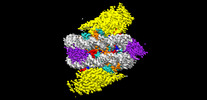



















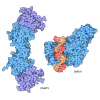






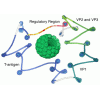




 Z (Sec.)
Z (Sec.) Y (Row.)
Y (Row.) X (Col.)
X (Col.)





















